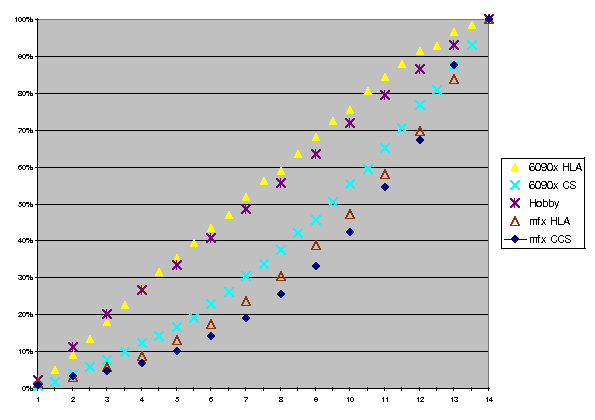The tests have been controlled with an Intellibox (MM2 protocol). Locos should show the same behaviour if controlled with a CU6021.
Speed was measured with the PC freeware PaTacho (available at
http://www.h0-freun.de/).The 6090x decoder has 27 speed steps.
With 5 pole high-efficiency propulsion you get a linear speed curve (6090x HLA, yellow triangles).
With c-sine motor, the curve is slightly bent (6090x CS, cyan crosses).
The new Hobby locos (here 36858, class 185) have a linear speed curve, but only 14 speed steps (violett crosses).
The mfx sound decoder with high-efficiency propulsion uses 14 speed steps with MM2 protocol; the speed curve (red triangles) is bent more than the C-Sine speed curve.
And finally a mfx sound decoder with the new compact C-Sine motor. The speed curve (blue diamonds) shows a sharp curve. Speed steps 11 through 14 result in 54%, 67%, 88%, and 100% of maximum speed respectively.

Loco speeds (x axis) are scaled to 100% (maximum speed).
Y axis shows the speed steps of the MM2 protocol (1 through 14); intermediate speed steps of 6090x are shown as 1.5, 2.5, &c.
I like the speed characteristics of the 6090x decoders; I make use of the 27 speed steps especially in the low speed range.
The speed characteristics of the new hobby locos are very similar to the older 6090 decoders (14 speed steps, not shown on chart).
The speed curve of mfx HEP locos is OK, but I'd prefer a rather linear speed curve.
The speed curve of mfx with new compact C-Sine is a shame: speed step 11 of 14 (that's 190 of 250 on a CU6021) reaches more than 50%.
These are the factory default speed curves.
With a CS the speed curves of mfx decoders can be adjusted; I wonder if the compact C-Sine can be set to a linear speed curve.
I won't be able to test this in the near future.